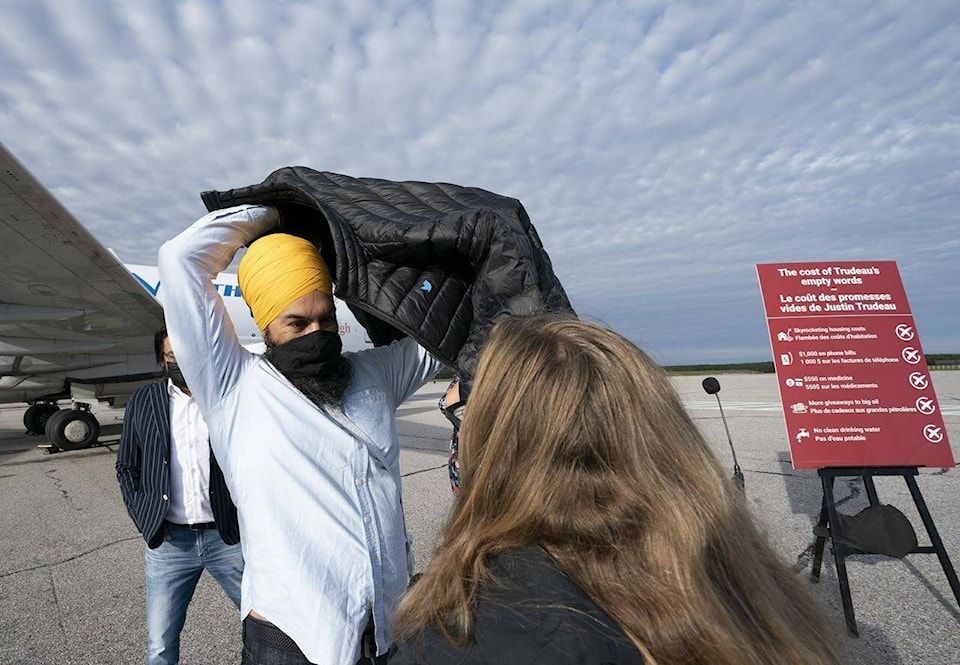By Bruce Cameron, Black Press Political Columnist
In February 2019, NDP leader Jagmeet Singh first won election to Parliament in the by-election for Burnaby South, a vacancy created by the resignation of NDP MP Kennedy Stewart, who went on to become Mayor of Vancouver. Nothing signifies the decidedly west-coast bent of the federal NDP more than that alignment of political opportunities.
The NDP won 24 seats in the 2019 federal election, and almost half (11) are in B.C., with polling consistently showing that the party’s political stronghold is on the coast. Yet polling data suggests that the NDP remains in some tight races in B.C. with the Liberals and Conservatives, and to a lesser extent the Greens. Aggregated polling numbers indicate NDP support nationally has edged upward from around 17 per cent pre-writ to about 20 per cent in the final stretch of the campaign. In B.C., NDP support is in the 30 per cent range, with the Liberals and Conservatives also around that mark.
Meanwhile, the national fight is still a Liberal-Conservative battle, and most modelling of results (based on polls and riding by riding splits) suggest that a minority Parliament is the most likely outcome (85 per cent chance, according to the CBC Poll Tracker). Despite trailing the Conservatives at the mid-way point of the campaign, the Liberals have edged within a statistical tie of the lead, and their comparative strength in vote-rich areas around Montreal and Toronto gives them double the odds (one in 10) of forming a majority government than the Conservatives (a one in 20 chance).
Those polling numbers point to a strong likelihood that the NDP will hold the balance of power in a divided Parliament. The strength and character of the party that holds the balance of power will largely be determined by B.C. voters in a handful of races. One race to watch will be Port Moody-Coquitlam, where the 2019 result was a three-way split between the CPC (MP Nelly Shin is running for re-election), the NDP (Bonita Zarrillo, who is running again in 2021, was within 157 votes) and the Liberals (who were only 1,100 votes from victory).
In a best-case scenario for the NDP, it will see a surge in support, and defeat incumbents from all three other parties.
Conservative seats the NDP will be watching include Port Moody-Coquitlam and Kootenay Columbia (where NDP candidate Wayne Stetski is looking to repeat his 2015 upset). They will also watch closely to see if NDP MP Richard Cannings can retain his seat in a close race with Conservative Helena Konanz in South Okanagan-West Kootenay (won in 2019 by less than 1,000 votes).
Seats the NDP hopes to gain from Liberal incumbents include Burnaby-North Seymour, where well known NDP candidate Svend Robinson lost to Liberal MP Terry Beech in 2019 by 1,600 votes. Beech is running for his third term as MP for the area and is unlikely to be defeated unless there is a huge NDP surge on election day, despite the NDP running a well-known local councillor, Jim Hanson. Another potential upset the NDP envision if an orange surge develops is in West Vancouver-Sunshine Coast-Sea-to-Sky, where Liberal MP Patrick Weiler is trying to fend off well-known personalities from the Conservatives (former MP for the area John Weston) and Leap Manifesto author and NDP candidate Avi Lewis, whose chances for an upset have risen due to the recent collapse of Green support. The Greens got almost 15,000 votes there in 2019, and if most of that vote now goes to Avi Lewis, this riding could end up becoming a close three-way race.
There is an old saying that two weeks is an eternity in politics. A few years ago, there was talk of the NDP losing its edge—and, along with it, the younger environmentally motivated social activist voting block—to the emerging Green Party. How times have changed.
To see how quickly perceptions can change, the NDP has only to look back to November 2020, when a Maclean’s article by Marie-Danielle Smith asked the question: “This should be the NDP’s time to shine, so why isn’t it?” In that article, which seems like a long time ago given how much positive momentum the NDP has created, Smith pointed out that when the Leap Manifesto was introduced in 2016, it was considered too radical by the leadership of the party.
With Jagmeet Singh’s popularity steadily growing, climate change increasing as a top issue, and social and economic divides becoming a mainstream topic for debate, the Leap Manifesto could even make a comeback. If the NDP’s Avi Lewis can pull off an upset in the beautiful mountainous riding north of Vancouver, that Manifesto may form a blueprint for the priorities of the next minority parliament.
Black Press Media’s election analyst Bruce Cameron has been a pollster for over 35 years, working initially for Gallup Polls, Decima Research and the Angus Reid Group before founding his own company, Return On Insight. He is a frequent media commentator in print and broadcast media.
Like us on Facebook and follow us on Twitter.
Want to support local journalism? Make a donation here.
